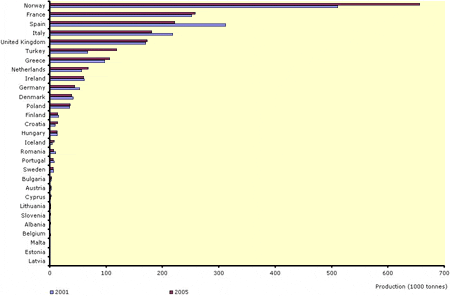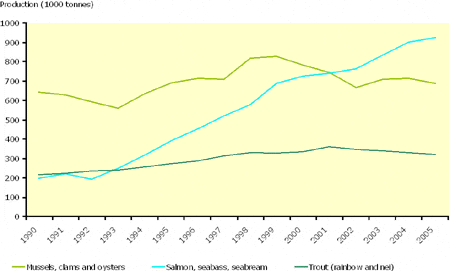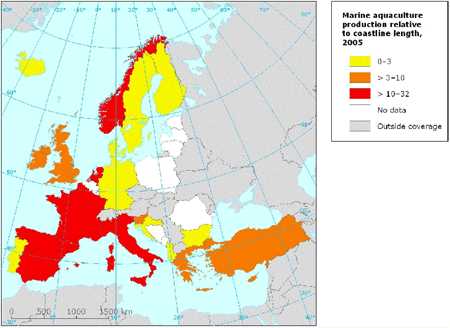This increase represents a rise in pressure on adjacent water bodies and associated ecosystems, resulting mainly from nutrient release from aquaculture facilities. The precise level of local impact will vary according to production scale and techniques as well as local and regional hydrodynamics and chemical characteristics.
Annual aquaculture production by major area
A significant increase in total European aquaculture production has been observed in the past 15 years although this has slowed since 1999. In general, significant improvements in the efficiency of feed and nutrient utilisation as well as environmental management have served to partially mitigate the associated increase in environmental pressure.
The increase in both production and pressure on the environment has not been uniform across countries or production systems. Only the mariculture sector has experienced a significant increase, while brackish water production has increased at a much slower rate and the levels of freshwater production have declined. On a regional level, EU 15 + EFTA countries dominate production by far.

Data source: FAO FISHSTAT Plus
Downloads and more info
Europe's fish farms fall into two distinct groups: the fish farms in western Europe grow high-value species such as salmon and rainbow trout, frequently for export, whereas lower-value species such as carp are cultivated in central and eastern Europe, mainly for local consumption.
The observed growth in production has not come without problems. According to DG Fisheries ''the European Aquaculture industry is facing a number of challenges in terms of market and of the environment. Its future will depend on its ability to become economically self-sufficient and its capacity to respond to environmental constraints''.
Production by country
The biggest European aquaculture producers are found in the EU 15 + EFTA region. Norway has the highest production with more than 650 thousand tonnes in 2005, followed by France, Spain, Italy and the UK. These 5 countries account for nearly 75% of all aquaculture production in 34 European countries. Even the smallest of these, the UK, produced 172 thousand tonnes in 2005, which is significantly higher than production in any European country outside of this region. Turkey's production of nearly 120 thousand tonnes represents, substantially the highest production in the countries grouped as EU-9+others.

Data source: FAO FISHSTAT Plus
Downloads and more info
The country ranking in 2005 in terms of production was very similar to that in 2001 although Spain and Italy both reduced their output significantly and whilst Norway increased its production by nearly 29%. Turkey increased its output from 2001 to 2005 by 77%.
It is noteworthy that in 2005, farming of Atlantic salmon in Norway (being about 90 % of Norway's total production) exceeded the combined total of all production species from countries grouped in EU 15 + EU 9 + others. France is the second biggest producer with production dominated by the Pacific cupped oyster (Crassostrea gigas) followed by Spain with production dominated by blue mussel. Turkish production consists mainly of trout, sea bream and sea bass.
Production by major commercial species groups
The major part of the increase in aquaculture production has been in marine salmon culture in northwest Europe, and to a lesser extent trout culture (throughout western Europe and Turkey), sea bass and sea bream cage culture (mainly Greece and Turkey), and mussel and clam cultivation (throughout western Europe), which however exhibits a downward trend since 1999. In contrast, inland aquaculture of carp (mainly common and silver carp) has declined significantly throughout eastern and central Europe (EU 15 + EU 9 + others) due partly to political and economic changes in eastern Europe. As in the case of production per country, no significant changes have been observed in production by major species since the last assessment.

nei = not elsewhere indicated. Trout (rainbow and nei) includes all species of trout.
Data source: FAO FISHSTAT Plus
Downloads and more info
Different types of aquaculture generate very different pressures on the environment, the main pressures being discharges of nutrients, antibiotics and fungicides. The main environmental pressures are associated with intensive finfish production, mainly salmonids in marine, brackish and freshwaters, and sea bass and sea bream in the marine environment, sectors which have experienced the highest growth rate in recent years. The pressures associated with the cultivation of bivalve molluscs, which include removal of plankton and local concentration and accumulation of organic matter and metabolites, are generally considered to be less severe than those from intensive finfish cultivation. Pond aquaculture of carp in inland waters usually requires less intensive feeding, and in most cases a greater proportion of the nutrients discharged are assimilated locally. Environmental pressure per unit production is likely to be less than for the more intensive salmonid production. Furthermore, this type of aquaculture has decreased in recent years.
Chemicals, particularly formalin and malachite green, are used in freshwater farms to control fungal and bacterial diseases. In marine farms, antibiotics are used for disease control but the amounts used have been reduced drastically in recent years following the introduction of vaccines and improved husbandry practices. In general, significant improvements in the efficiency of feed and nutrient utilisation as well as environmental management have served to partially mitigate the associated increase in environmental pressure.
What is the environmental performance of aquaculture?
Production relative to coastline length
The environmental pressures exerted by aquaculture are not uniform. The level of local impact will vary according to production scale and techniques as well as the hydrodynamics and chemical characteristics of the region. Of the EU 15 countries, Spain, France and the Netherlands, and of the EU 10 + Romania, Bulgaria, and Turkey, have the greatest marine aquaculture production in relation to coastline length.
Aquaculture production intensity as measured per unit coastline length has reached an average of around 8 tonnes per km of coastline in EU 10 + EFTA countries compared with 2 tonnes per km in the EU 10 + Romania + Bulgaria + Balkan region. The pressure is likely to continue to increase as the production of new species such as cod, halibut and turbot becomes more reliable.

Data source: FAO FISHSTAT Plus and World Resources Institute
Downloads and more info
By presenting production relative to coastline length, it is possible to determine a more comparable value of production density. This is potentially a better indicator of pressure than a single production value, but there are difficulties with this indicator. It is inappropriate for landlocked countries; it does not apply to freshwater production; it does not consider the area of coastline that is potentially suitable for production; and the determination of coastline length is problematic and relies upon uniform scale being used for each country's determination.
An alternative indicator could be based on the percentage coverage of key coastal habitat types by different types of aquaculture.
Contribution of nutrients from aquaculture to total coastal nutrients loads
Marine finfish aquaculture (mainly Atlantic salmon) is making a contribution to nutrient loads in coastal waters, particularly in the case of countries with relatively small total nutrient discharges to coastal waters. In general, the pressure from nutrients from the intensive cultivation of marine and brackish water could become significant in the context of total nutrient loadings to coastal environments. However the published data on total nutrient loadings to coastal waters remains poor in quality and inconsistent in coverage; the conclusions should therefore be treated with caution.
February 2009



